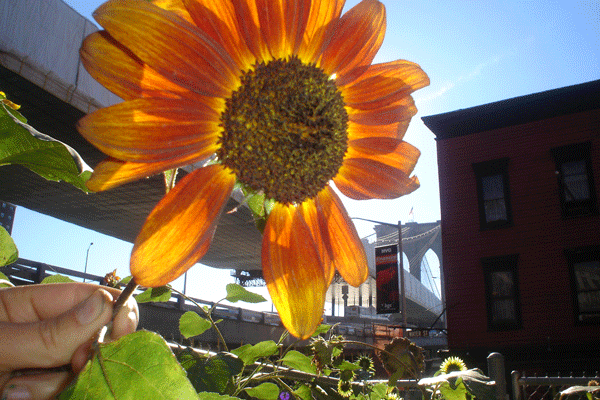
The plantings were the handiwork of Water Street resident Mackenzie Younger, 22, who graduated from the Rhode Island School of Design this spring. The idea started as a school project two years ago and blossomed from there.
Younger took a course at the neighboring Brown University titled “Medicinal Plants and Modern Medicine” in the school’s greenhouse. The experience made him think more about how important plants are to everyday life. He started a greenhouse project to revive interest in the environment and in living, growing art by planting sunflower seedlings around campus. “The class got me thinking about plants and how people don’t think about plants — and how essential they are to everything we do,” Younger told the Downtown Express.
In June, Younger began “The Sunflower Project,” which entailed sowing 2,500 seeds throughout the city’s five boroughs. Accompanied by childhood friend Johnny Kunen, Younger biked around the city, thumbing seeds into barren ground. “I was coming back to New York City after graduation and [wanted to] bring the larger inspiration to my home,” he said. “Over the course of two weeks, we biked to every neighborhood and scoped out places where most people would see the flowers.”
While sunflowers are known to be a universal sign of joy, “In many ways, the sunflowers represent the lack of room for things to flower and succeed in an urban environment,” according to Younger. With the dry summer weather, fewer flowers grew than the students expected: Only 15 to 20 percent of the seeds flourished.
However, the project’s success was measured not in the number of blossoms but in the reactions of people who saw them.
Some passersby who saw him and his friend digging around in the dirt thought they were planting weed. “Their only association with young people growing stuff in an urban place is narcotics,” he said. “It was funny. But the cops never stopped us.”
Throughout the summer, when he wasn’t planting, Younger would ride his bike around Downtown to check on the growing sunflowers. Quietly on the sidelines, he witnessed passersby cutting the flowers’ heads off to take them home and city workers mowing down the plants. But he had a Zen attitude toward it all.
“They are sacrificial plants,” he explained. “Birds eat them, squirrels bury them. A few seeds fall on the ground to carry on to the next year.
“Native Americans had sunflowers at the edge of their gardens to attract pollinators,” he added. “It’s another metaphor for what I’m doing.”
Younger explained that it was this cycle of life that drew him to the project. “The Bridge Café [on Water Street] has beehives on the roof, and the bees coming into the FishBridge Garden roll around in the flower faces, drink the water and return to their hives to make honey.” Rather than green guerilla action, he saw the experience as an urban art gallery.
The project as a whole is exemplary of how the outdoors constitutes an environmental art space for artists to use organic materials in order to express themselves, said Younger, adding that he hopes to broaden the project next year. “It’s tricky,” he said of the endeavor. “I don’t want to be the ‘sunflower guy,’ but I want to bring a broader range of indigenous plants to the city. I see a future filled with green roofs and green streets. I would like the island of Manhattan to incorporate more animals and birds.
Most of all, the project taught Younger how an interactive network of animals, birds and plants is necessary for a prosperous environment. “I’m more interested in the balance thing — allowing more things to exist together,” he said.
































